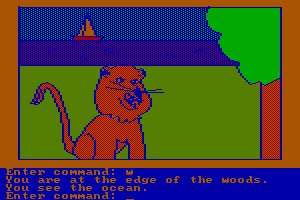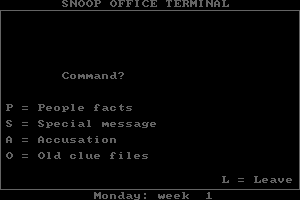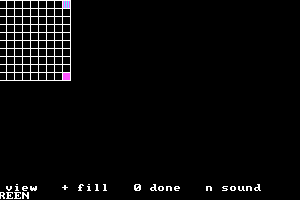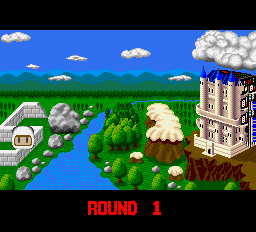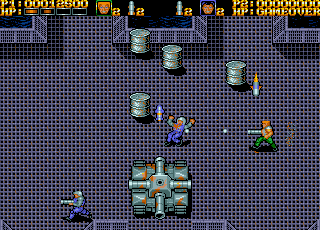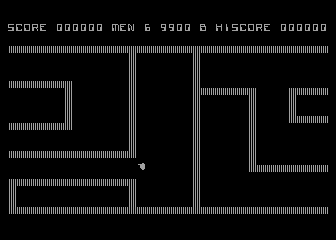Encyclopedia of War: Ancient Battles
DOS - 1988
Also available on: Amiga - Amstrad CPC - ZX Spectrum
Description of Encyclopedia of War: Ancient Battles
This gem was supposed to be the first in a series by a small English company. The reviews at the time were glowing, but unfortunately the game didn't sell well. It comes with ready made scenarios from Ancient Egyptian times to the time of Rome. You can devise your own battles on custom-made battlefields easily with an astounding selection of historical units to choose from.
Recreate ancient battles by finding out unit disposition and terrian or just play for fun..this game simulates the nature of Ancient Warfare at a fast and fun..yet accurate pace. Printouts are available after each battle as well.
Review By HOTUD
External links
Captures and Snapshots
Comments and reviews
The Pilgrim 2020-08-13 5 points
Finally, a bit of historical background to help you pick your battles.
- Early Middle Eastern: New Kingdom Egypt, Hittites, Assyrians and Babylonians.
Their armies are basically made up of charriots and big units of low-quality infantry, with a few elite units. Their battles involve the massive use of charriots as shock force while the very few worthy infantry tries to delay the crumbling of the line under the pressure. Historically, all their territories ended up under the control of the Achaemenid Empire, represented in the game by the Early Persians, who discarded charriots for cavalry.
- The Greco-Persian wars: Early Spartans and Early Persians.
The game also includes an *.UDF army list for Greeks, which can be accessed by the Campaign Manager, and is useful for playing battles of the classical greek era, including the Peloponese War. Those are battles dominated by the elite greek phalanxes.
- Alexander the Great: Alexandrian Macedonians, Late Persians, Indians.
For the battles of Alexander, but also the typical civil wars of the late Archaemenid Empire (Late Persians comes with the option to chose either a Royal or a Rebel army). The battle of Hydaspes, fought by Alexander at the far lands of India, comes as an scenario in the game. Beware the Elephants!
- Hellenistic Period: Antigonid Macedonians, Seleucids, Ptolemaic Egyptians.
After the death of Alexander, the succesor states fought each other for centuries, and lived long enough to see some action against the Republican Romans before being eventually crumbled by the Professional Romans (and, in the case of the Seleucids, also the Parthians). The game includes an *.UDF army list for the Bactrians, a succesor state on the eastern part of the Seleucid Empire. It can be accessed by the Campaign Manager.
- The Punic Wars: Republican Romans, Carthaginians.
Trying to follow the steps of Hannibal against the army with the best infantry in the game is no easy task, and requires having mastered the proper use of cavalry. The battle of Zama between Scipio and Hannibal comes as an scenario in the game. But the Carthaginians are not the only enemy of Rome in this period, as they will also face the Antigonid Macedonians. The battle of Cynoscephalae between the romans and the macedonians also comes as an scenario. After defeating them, the Romans will then engage the Seleucids.
- Late Roman Republic: Gauls, Profesional Romans, Parthians, Early Germans.
Those are useful for replaying battles like those of Caesar in the conquest of Gaul, the many Civil Wars in Rome like Marius vs Sulla, Caesar vs Pompey, or Octavian vs Antony. Also the fall of the Ptolemaic Egyptians, conquered by Rome, and of the Seleucids, under both roman and Parthian pressure. After taking over the Seleucids, the Parthians can give the romans a nasty surprise with a well-timed Cataphract Cavalry Charge.
- Rise of the Roman Empire: Imperial Rome, Sassanid Persia, Palmyra
Imperial Rome is battling the Early Germans in the west while it continues to wage war against the Parthians in the east. Towards the 3rd century, Parthia is taken over by Sassanid Persia, who also inherit the title of Rome's main enemy. Palmyra rises as a new contestant fighting both the persians and the romans.
- Decline of the Empire: Huns, Visigoths, Later Romans.
Armies for the battles in the latter years of the western roman empire. The Battle of Chalons against Attila, regarded as the Roman Empire's last victory, comes as an scenario in the game.
The Pilgrim 2020-08-13 5 points
Now after explaining the basics, let's get on some strategic advice about how to actually carry on a battle.
In order to win the battle, you need to get enemy units to break and flee. A battle isn't won by the side that provokes more casualties, but by the side that has more remaining points worth of units standing on the battlefield. Killing enemy soldiers is a means to an end, not an end in itself.
The basic way to throw enemy units into panic is to flank them with two or more of your own units. As more enemy units get broken, more of your own units become free to achieve flankings, eventually crumbling all the enemy army into disarray. That's your main objective, which you must achieve while preventing the enemy army from crumbling yours.
With that objective in mind, we can take a look at the different unit types and study their roles in the battlefield (Battle Line, Shock Units, Enveloping Units, and Skirmishers).
- Battle Line Units: The task of infantry formations (HI, SP and BI) is to form your main line and keep it for as long as possible. Position your elite infantry so that when the infantry lines clash, it can either create punctures in the enemy line, or prevent the enemy elite infantry from puncturing yours.
- Shock Units: EL, SCH, HCH, CAT and, in a pinch, HCL. Their job is to strike at the enemy line in a straight charge and send it into disarray, opening holes for the rest of your forces to exploit. They work against weak infantry, but good quality infantry will usually roll with the punch and send them back in disarray.
- Enveloping Units: The main role of your HC. They are unable to break infantry in a straight charge, and will usually refuse to engage infantry on a head-on even if ordered to do so. Their use is to be deployed at the flanks, win the cavalry battle, then proceed to envelope the enemy infantry line (hopefully white it's still engaged with your own infantry line). HCL is usually best used for this function as well. Learning to maneuver cavalry is the trickiest part of this game. It's adviseable to always position at least a General in each flank, as they can issue orders for free to units they are stacked with and those adjacent.
- Skirmishers: LCH, LC and LI. It's easy to overlook the value of those units. They are very cheap and can draw away the attention of enemy units worth a lot more points than them. As the enraged enemy attempts to chase them, they will automatically disengage, making him lose a valuable time he could have used in flanking and breaking your units. Sometimes your skirmishers can even provide a decisive flanking in support of your units. A General that knows how to make use of his skirmishers is at a huge advantage over one that doesn't.
So, that's the basic strategic advice you need to get going.
The Pilgrim 2020-08-08 5 points
As his tittle suggest, Ancient Battles is a good encyclopedia of pre-medieval armies. The number of available armies is huge and they are very well documented. It remains an interesting title just for that. It also has an army editor that allows you to define your own armies and units.
Actual gameplay is less thrilling, and involves mostly watching the computer play alone as the armies clash.
The game comes with three exe files:
- ab.exe allows you to play the battle part of the game, but crashes if you go into campaign mode.
- campaign.exe allows you to create and edit new army lists (you can't edit the default ones in the game), but crashes if you try to go into battle mode.
- battle.exe is the file you should execute, as it allows to change from battle to campaign mode and back without problems.
Unless you chose to play an existing scenario, you must create and deploy your army before going to battle. You can chose the two opposing armies and a point-value limit for each, then purchase the units, then deploy them into the map. If you assign an army to computer control, you still get to purchase it, but the computer deploys it, so always chose both human and switch one to computer control later. You can also design a map (and save it) or load a previously existing one.
Up to here, the game is more or less intuitive to play. But things change when you get to the battle. Once in battle, you can issue a very limited number of orders to your units, and maneuvering is slow, if at all. So the outcome depends much of the deployment you made.
Each unit has the following basic stats:
- Unit type (more about it later)
- Size: Number of men fighting, has an effect on damage inflicted and ability to sustain damage before fleeing.
- Fatigue: normally starts at 0 and increases during the battle, has an important effect on both damage inflicted and ability to sustain damage before fleeing.
- Morale: Has a huge effect on when the unit will retreat or break and flee. A single point of morale advantage means the enemy is likely to flee first. A retreating unit is bad news, but a broken one means that unit is effectively out of the battle, as broken units doesn't rally, they just flee towards your bottom of the field and leave it.
- Armour: Units can be (unarmoured, armoured, heavy armoured, plate), with the two latter normally only seen in cavalry. The more armour, less casualties (and more casualties become wounded instead of killed in campaign games). Units also can have a shield, which protects a lot from missile weapons, and cavalry can have barded horses, which protects them from missile weapons further.
- Skill: That's how skillfull the troops are, the more skill the more casualties they provoke.
- Missile: Missile weapons available to the unit: Bow, Javelin, Mixed, Sling. Bows have longer reach than javelins, javalins have more shock value before engaging in combat, slings have more punch against armoured targets, and mixed is a mix of bows and javelins. Troops also have a skill in the use of those weapons and a percentage of men in the unit equipped with them.
- Traits: Units can be drilled (they react to orders faster), disciplined (they require less command points to order), wild (they fight more vigorously until fatigated), and pike phalanx (spearmen only, actual effect undocumented in the game manual).
Here is a summary of the unit types and their use:
* Generals:
Those are small units that can (and should) be deployed on top of other units. They will rapidly flee if catch alone. In addition to giving a morale and fighting bonus to the unit they are stacked with, they can issue orders to other units. The first general you purchase will have default command over all the army, the next ones you will have to issue units to them during the deploy. Each general has 4 command points on the first turn of the battle and 2 in all the subsequent ones. The orders he can issue are:
- Move: The unit will attempt to move to the square you commanded it to move.
- Advance: Keep moving straight until reaching the furthest square on the map.
- Follow: Mimic the movement of the last unit that was given move or advance orders, trying to mantain the relative positions of both units.
Move/Advance costs 2 command points to issue (or 1 if the unit is disciplined), and there can be a delay before the unit begans to obey it (more likely the further the unit is from the general, less likely if the unit is drilled). Issuing orders to units stacked with a general or next to it has no cost neither delay. Follow orders are free, but the following unit must be close to the leading unit.
- Heavy Infantry (HI): Infantry in close formation. Good to keep the line.
- Spearmen (SP): Much like HI but weaker if flanked.
- Barbarian Infantry (BI): Infantry in loose formation. Less resilient than HI or SP, but faster and better on rough terrain.
- Light Infantry (LI): Infantry in open formation, armed with missiles. Will harass the enemy avoiding to get catched into close combat, in which case they will rapidly flee.
- Heavy Cavalry (HC): Normally the backbone of the cavalry forces, they can't defeat infantry on a straight charge, but can flank it effectively. Most battles are won by whoever wins the cavalry battle in the flanks.
- Light Cavalry (LC): Much like light infantry, but faster and thus more able to remain uncaught.
- Cataphracts/Lancers (CAT, HCL): Heavy armoured cavalry with lances, are more effective than HC against infantry, but will still fail to break good HI or SP. Present only in later armies.
- Elephants (EL): Shock units, cavalry automatically flees from them, good HI and SP normally can withstand them. Infantry equipped with missile weapons puts them into flight fast. Once broken, they will trample over any unit they come by, friend or foe.
- Charriots (HCH, LCH, SCH): Present only in early, pre-cavalry armies. They come in Heavy, Light and Scythed flavours. HCH are basically like HC, LCH are like LC. SCH have good shock value against weak infantry and, like elephants, will trample over friendly units if fleeing.
Those are the basics.
Write a comment
Share your gamer memories, help others to run the game or comment anything you'd like. If you have trouble to run Encyclopedia of War: Ancient Battles, read the abandonware guide first!
Download Encyclopedia of War: Ancient Battles
We may have multiple downloads for few games when different versions are available. Also, we try to upload manuals and extra documentation when possible. If you have additional files to contribute or have the game in another language, please contact us!
DOS Version
Amiga ROM
- Year: 1990
- Publisher: Cases Computer Simulations Ltd.
Amstrad CPC Version
- Year: 1988
- Publisher: Cases Computer Simulations Ltd.
ZX Spectrum Version
- Year: 1989
- Publisher: Cases Computer Simulations Ltd.
Similar games
Fellow retro gamers also downloaded these games:



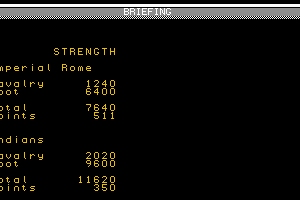



















 279 KB
279 KB